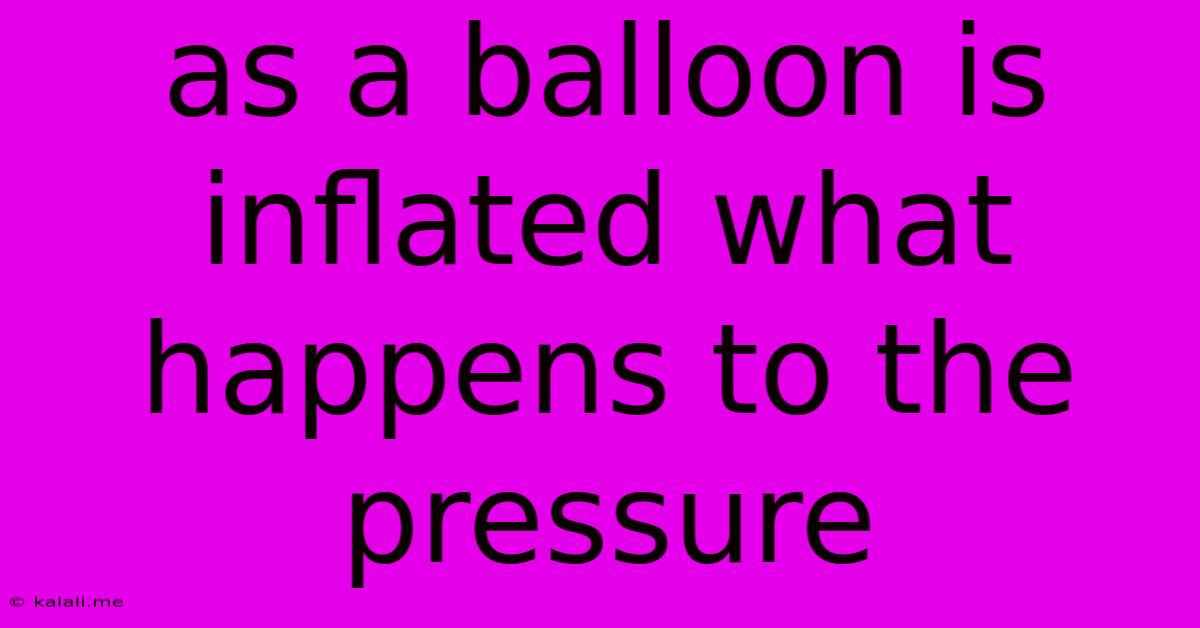As A Balloon Is Inflated What Happens To The Pressure
Kalali
Jun 06, 2025 · 3 min read

Table of Contents
As a Balloon is Inflated: What Happens to the Pressure?
Meta Description: Discover the relationship between balloon inflation and pressure. Learn about Boyle's Law and how it explains the increasing pressure inside a balloon as more air is added. Understand the factors influencing pressure and the eventual bursting point.
Have you ever blown up a balloon and noticed how much harder it gets to inflate as it gets bigger? That's because the pressure inside the balloon is increasing. This isn't just a fun observation; it's a great example of a fundamental principle in physics: Boyle's Law. This article will delve into the fascinating relationship between balloon inflation and the pressure it generates.
Boyle's Law and Balloon Inflation
Boyle's Law states that the pressure and volume of a gas have an inverse relationship, provided the temperature remains constant. In simpler terms: as the volume of a gas increases, its pressure decreases, and vice versa. When you inflate a balloon, you're increasing the volume of air inside. To accommodate this increased volume, the air molecules spread out, leading to an increase in the force they exert on the balloon's inner surface – this is the pressure.
The more air you add, the more compressed the air molecules become within the limited space of the balloon. This compression directly translates to a higher pressure. You can feel this increase in pressure as the balloon becomes more resistant to further inflation.
Factors Affecting Pressure Inside a Balloon
Several factors influence the pressure inside a balloon beyond simply adding more air:
- Amount of Air: The most obvious factor; more air means more molecules colliding with the inner surface, resulting in higher pressure.
- Temperature: Increasing the temperature of the air inside the balloon increases the kinetic energy of the air molecules, causing them to collide more frequently and forcefully, thus increasing the pressure. Conversely, cooling the air reduces pressure. This is why balloons deflate faster in cold weather.
- Balloon Material: The elasticity and thickness of the balloon material affect its ability to stretch and accommodate increased pressure. Thinner balloons will burst at lower pressures than thicker, more robust ones.
- Balloon Shape: While less impactful than the other factors, the shape of the balloon can slightly influence the pressure distribution within it.
The Bursting Point
Eventually, the pressure inside the balloon will exceed the tensile strength of the balloon material. At this point, the balloon bursts. The bursting point is determined by the interplay between the internal pressure and the balloon's material properties. A high-quality, thick balloon can withstand significantly higher pressure than a thin, low-quality one.
Beyond Balloons: Real-World Applications
Understanding the relationship between pressure and volume is crucial in many applications beyond just inflating balloons. This principle is fundamental to understanding:
- Scuba diving: The pressure experienced by divers increases with depth, impacting their bodies and equipment.
- Weather patterns: Changes in atmospheric pressure are key to understanding weather phenomena like storms and high-pressure systems.
- Engine design: Internal combustion engines rely on precise control of pressure and volume to function effectively.
In conclusion, inflating a balloon provides a simple yet effective illustration of Boyle's Law and the relationship between pressure and volume. The pressure inside the balloon increases as it expands, leading to the increasingly difficult inflation and the eventual bursting point. This principle underpins numerous scientific and engineering applications in our daily lives.
Latest Posts
Latest Posts
-
How To Find Lost Car Keys
Jun 07, 2025
-
Did The Early Church Believe In The Rapture
Jun 07, 2025
-
Nest No Power To Rh Wire
Jun 07, 2025
-
How To Cite A Screenshot In Apa
Jun 07, 2025
-
Does Dfa Only Have One Start Node
Jun 07, 2025
Related Post
Thank you for visiting our website which covers about As A Balloon Is Inflated What Happens To The Pressure . We hope the information provided has been useful to you. Feel free to contact us if you have any questions or need further assistance. See you next time and don't miss to bookmark.